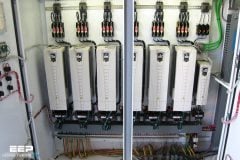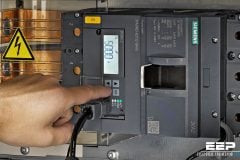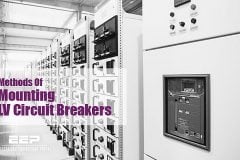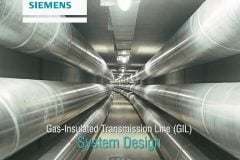Enclosure protection (IP) code
As you already probably know, IP stands for Ingress Protection. International Electrotechnical Commission – IEC 60529 “Degrees of protection provided by enclosures (IP Code).”. NEMA offers a similar rating system.

In order to protect live parts of equipment being contacted by foreign solid bodies or liquid, and also to prevent persons or livestock from coming into contact with live or moving parts, such equipment is housed inside an enclosure.
The degree of protection offered by such an enclosure is indicated by an index of protection (IP) code, as shown in Table 1 below.
First numeral // Mechanical protection
| No. | Description |
| 0 | No protection of persons against contact with live or moving parts inside the enclosure. No protection of equipment against ingress of solid foreign bodies. |
| 1 | Protection against accidental or inadvertent contact with live or moving parts inside the enclosure by a large surface of the human body, e.g. a hand, but not protection against deliberate access to such parts. Protection against ingress of large solid foreign bodies. |
| 2 | Protection against contact with live or moving parts inside the enclosure by fingers. Protection against ingress of medium-size solid foreign bodies (12.5 mm spheres). |
| 3 | Protection against contact with live or moving parts inside the enclosure by tools, wires or such objects of thickness greater than 2.5 mm. Protection against ingress of small foreign bodies. |
| 4 | Protection against contact with live or moving parts inside the enclosure by tools, wires or such objects of thickness greater than 1 mm. Protection against ingress of small solid foreign bodies. |
| 5 | Complete protection against contact with live or moving parts inside the enclosure. Protection against harmful deposits of dust. The ingress of dust is not totally prevented, but dust cannot enter in an amount sufficient to interfere with satisfactory operation of the equipment enclosed. |
| 6 | Complete protection against contact with live or moving parts inside the enclosures. Protection against ingress of dust. |
Second numeral // Liquid (water) protection
| No. | Description |
| 0 | No protection. |
| 1 | Protection against drops of condensed water. Drops of condensed water falling on the enclosure shall have no harmful effect. |
| 2 | Protection against drops of liquid. Drops of falling liquid shall have no harmful effect when the enclosure is tilted at any angle up to 15° from the vertical. |
| 3 | Protection against rain. Water falling in rain at an angle equal to or smaller than 60° with respect to the vertical shall have no harmful effect. |
| 4 | Protection against splashing. Liquid splashed from any direction shall have no harmful effect. |
| 5 | Protection against water jets. Water projected by a nozzle from any direction under stated conditions shall have no harmful effect. |
| 6 | Protection against conditions on ships’ decks (deck with water-tight equipment). Water from heavy seas shall not enter the enclosures under prescribed conditions. |
| 7 | Protection against immersion in water. It must not be possible for water to enter the enclosure under stated conditions of pressure and time. |
| 8 | Protection against indefinite immersion in water under specified pressure. It must not be possible for water to enter the enclosure. |
| X | Indicates no specified protection. |
It will be seen from Table 1 that, for instance, an enclosure to IP 56 is dustproof and waterproof.
These notions of protection have a large influence on the design of equipment because protection has to be assessed not only by the external enclosure, but also by internal enclosures or parts of internal enclosures (partitions, shutters, etc).
Therefore the degree of protection of persons has to be defined also for internal parts which can initiate a direct contact during an operation, for instance when withdrawing a circuit- breaker.
Two kinds of compartments are considered in this case:
1. Those which are opened only rarely (bus bars) and for which bolted covers can be considered as satisfactory. Opening them being not a simple operation, it is supposed that adequate precautions dictated by safety requirements will be taken.
2. Those which may have to be opened during normal operation of the equipment. They are generally closed by doors which can be locked or blocked by an additional control system which completes the protection provided by the enclosure.
During all these service and maintenance operations the electrical continuity of the enclosure must not be interrupted whatever the position of the equipment is.
NEMA rating
How do I cross-reference with an IP rating?
Two widely accepted rating systems are the NEMA and the IP codes. NEMA, short for National Electric Manufacturers’ Association, is commonly specified at installations in the U.S.A. IP, which is an abbreviation for International Protection, is derived from the IEC. IP and IEC are more common in Europe and Asia.
Here are the NEMA 250 classifications:
| No. | Description |
| 1 | Intended for use primarily to provide a degree of protection against limited amounts of falling dirt. |
| 3 | Outdoor protection against rain, sleet, windblown dust, and damage from external ice formation. |
| 3R | Outdoor, protection against rain, sleet, and damage from external ice formation. |
| 3S | Outdoor, protection against rain, sleet, windblown dust, and to provide for operation of external mechanisms when ice laden. |
| 4 | Indoor/Outdoor, protection against windblown dust and rain, splashing water, hose-directed water and damage from external ice formation. |
| 4X | Indoor/Outdoor, protection against corrosion, windblown dust and rain, splashing water, hose-directed water and damage from external ice formation. |
| 6 | Indoor/Outdoor, protection against hose-directed water, the entry of water during occasional temporary submersion at a limited depth and damage from external ice formation. |
| 6P | Indoor/Outdoor, protection against hose-directed water, the entry of water during prolonged submersion at a limited depth and damage from external ice formation. |
| 12 | Indoor, protection against circulating dust, falling dirt and dripping non-corrosive liquids. |
| 12K | Type 12 with knockouts |
A Brief Comparison of NEMA 250 and IEC 60529
| NEMA Enclosure | IEC Enclosure |
| 1 | IP10 |
| 3 | IP54 |
| 3R | IP14 |
| 3S | IP54 |
| 4 and 4X | IP56 |
| 6 and 6P | IP67 |
| 12 and 12K | IP52 |
References:
- Electric Wiring: Domestic – B. Scaddan
- Schneider Electric Cahier technique 166











What does the ‘2-8 hr’ clause that accompanies IP65 mean in terms of practical value? I know it has to do w/ vacuum suction of talc powder, but somewhere somehow I got the impression that IP65 only prevents ingress of particles which gravitate within 8 hrs. Particles remaining airborne beyond that can get into the motor.
Particles 1 um or smaller remain airborne indefinitely. A good example is sawdust which can attain sizes of 0.5 um.
Sawdust got into an new Ebike hub motor & within 10 days, the motor was toast. Sent to distributor who saw rust in patches throughout motor (not like water damage which is confluent & diffuse, spraying about as motor spins). Sawdust causes damage by direct contact leading to rust, corrosion & ruining of finishes.
But if IP65 is DUST TIGHT how could this happen?
Is IP65 dust tight for EVERY kind of dust IN THE WHOLE WORLD?
Does the 2-8’hrnclause have anything to do w/ limitations of IP65 & dust coverage?
Please help if you can. It’s very NB as there’s a lot going on behind the scenes here. :)
Thank you
Its helpful..
Great article. It is also important to ensure that the continuity ingress protection of the enclosure is maintained when installing electrical equipment or components.
We get a lot of questions from our customers when it comes to installing equipment into enclosures, even if the both have adequate IP ratings, the ratings usually doesn’t relate to the protection offered to the enclosure entry.
We’ve explained this point in more detail here: http://www.etscc.co.uk/blog-home/maintaining-ip66-cable-gland-enclosure-entry-q-and-a
I think there’s a mistake in the last table.
No way a NEMA 4X cabinet can be equivalent to a IEC IP55 one
NEMA4/4X is equivalent to IP65 / IP66
good and useful article thanks!!!
you are providing tremendous knowledge